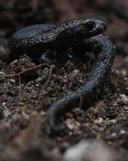|
Bolitoglossa subpalmata (Boulenger, 1896)
La Palma Salamander Subgenus: Eladinea | family: Plethodontidae subfamily: Hemidactyliinae genus: Bolitoglossa |
 © 2013 Eduardo Boza Oviedo (1 of 8) |
|
|
|
Description Distribution and Habitat Country distribution from AmphibiaWeb's database: Costa Rica
Life History, Abundance, Activity, and Special Behaviors Trends and Threats Possible reasons for amphibian decline General habitat alteration and loss Comments A phylogenetic study (maximum parsimony) based on sequences of mt-cytochrome b show that B. subpalmata may be sister to B. tica. These species are not sympatric (Garcia-Paris et al. 2008). A Spanish-language species account can be found at the website of Instituto Nacional de Biodiversidad (INBio).
References
Brame, A. H., Jr. and Wake, D. B. (1972). ''New species of salamanders (genus Bolitoglossa) from Colombia, Ecuador, and Panama.'' Contributions in Science, Natural History Museum of Los Angeles County, 219, 1-34. García-París, M., Parra-Olea, G., and Wake, D.B. (2008). ''Description of a new species of the Bolitoglossa subpalmata group (Caudata: Plethodontidae) from Costa Rica.'' Herpetological Journal, 18, 23-31. Hanken, J. (1979). ''Egg development time and clutch size in two neotropical salamanders.'' Copeia, 1979(4), 741-744. Parra-Olea, G., García-París, M., Hanken, J., and Wake, D.B. (2004). ''A new species of arboreal salamander (Caudata: Plethodontidae: Pseudoeurycea) from the mountains of Oaxaca, Mexico.'' Journal of Natural History, 38, 2119-2131. Wake, D. B., Lynch, J. F. (1976). ''The distribution, ecology, and evolutionary history of plethodontid salamanders in tropical America.'' Natural History Museum of Los Angeles County Science Bulletin, 25(1), 1-75. [link] Originally submitted by: Arie van der Meijden (first posted 2001-02-22) Edited by: Kellie Whittaker (2010-09-21) Species Account Citation: AmphibiaWeb 2010 Bolitoglossa subpalmata: La Palma Salamander <https://amphibiaweb.org/species/4018> University of California, Berkeley, CA, USA. Accessed Nov 22, 2024.
Feedback or comments about this page.
Citation: AmphibiaWeb. 2024. <https://amphibiaweb.org> University of California, Berkeley, CA, USA. Accessed 22 Nov 2024. AmphibiaWeb's policy on data use. |




 Raffaëlli Account
Raffaëlli Account Map of Life
Map of Life